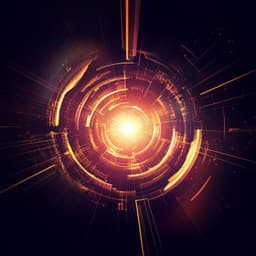
Physics
A detailed map of Higgs boson interactions by the ATLAS experiment ten years after the discovery
T. A. Collaboration
The ATLAS Collaboration has unveiled significant advancements in the study of the Higgs boson, boasting a dataset over 30 times larger than previous records. Their research not only showcases precise measurements of the Higgs boson's interactions with elementary particles but also confirms the remarkable consistency of its properties with Standard Model predictions, hinting at stringent constraints on new physics theories.
~3 min • Beginner • English
Introduction
The paper investigates whether the Higgs boson’s interactions (couplings) with Standard Model particles follow the mass-proportional pattern precisely predicted by the Standard Model. Building on extensive LHC Run 2 data collected by ATLAS (2015–2018), the study combines measurements across many Higgs production mechanisms (ggF, VBF, VH, ttH, tH) and decay modes (to vector bosons and fermions), to extract production rates, branching fractions, and coupling modifiers. This comprehensive approach aims to rigorously test the Higgs sector, search for deviations that could indicate physics beyond the Standard Model, and constrain possible invisible or undetected Higgs decays.
Literature Review
The study places its work in the context of extensive prior tests of the Standard Model and the 2012 Higgs discovery by ATLAS and CMS. Run 1 analyses established the Higgs-like particle’s spin-0 nature, excluded spin-1 and spin-2 hypotheses at high confidence, and found CP properties consistent with a CP-even state. Early measurements, although compatible with the Standard Model, had substantial statistical uncertainties that left room for non-SM interpretations. Subsequent improvements included precise Higgs mass measurements by ATLAS and CMS and more detailed coupling studies. The paper builds on and supersedes earlier ATLAS combinations that used partial Run 2 datasets, incorporating improved reconstruction, simulation, and theoretical predictions.
Methodology
- Dataset and detector: Uses the full ATLAS Run 2 pp collision dataset at √s = 13 TeV, totaling 139 fb^-1 (2015–2018). The ATLAS detector is a multipurpose apparatus with near 4π coverage, featuring an inner tracking spectrometer, electromagnetic and hadronic calorimeters, and a muon spectrometer, with a two-level trigger operating at ~1 kHz from 40 MHz bunch crossings.
- Processes and channels: Considers six Higgs production processes (ggF, VBF, WH, ZH, ttH, tH) and a broad set of decay modes: H→ZZ→4ℓ, H→WW→2ℓ2ν (separately targeting ggF, VBF, and VH), H→γγ, H→Zγ→ℓℓγ, H→bb (in VH, VBF, ttH, and, as new input, boosted ggF-like topologies), H→ττ (extended sensitivity to VH and combined ttH+tH), ttH multi-lepton final states, H→μμ, and H→cc (accessed via VH). Direct searches for invisible Higgs decays are included via VBF and ZH signatures.
- Event classification: For each decay mode, events are categorized by production mode using properties of associated particles, often with dedicated machine-learning classifiers. Additional categorization by kinematics (e.g., Higgs pT, jet multiplicities) further probes coupling structure and potential BSM effects.
- Simulation and backgrounds: Signal efficiencies and most background yields are determined from detailed MC simulation using common event generators, passed through full ATLAS detector simulation and reconstruction. Control regions in data constrain key backgrounds and calibrations.
- Statistical framework: A global likelihood is constructed as the product of likelihoods from all inputs. Systematic uncertainties (experimental and theoretical) enter as nuisance parameters, constrained by data or Gaussian priors. Fits use the profile likelihood ratio; confidence intervals and p-values use asymptotic formulae. Uncertainties are decomposed into statistical, experimental, and theory (signal and background) components by fixing subsets of nuisance parameters at best-fit values.
- Measurement strategy: Extracts global signal strength μ, per-production cross-sections (assuming SM branching fractions), per-decay branching fractions (assuming SM production cross-sections), and production×branching products with minimal assumptions. Coupling analyses employ κ-framework parameterizations, including scenarios with common fermion/vector scale factors and fully resolved κW, κZ, κt, κb, κc, κτ, κμ, with loop-induced processes either expressed via fundamental couplings or via effective κ parameters. Scenarios both excluding and allowing invisible/undetected BSM decays are tested with appropriate constraints.
- Kinematic studies: Uses the simplified template cross-sections framework, partitioning phase space into 36 regions designed to be sensitive to deviations while minimizing theory uncertainties and model dependence, enabling differential-like probes of the Higgs interactions.
Key Findings
- Global signal strength: μ = 1.05 ± 0.06 = 1.05 ± 0.03 (stat.) ± 0.03 (exp.) ± 0.04 (signal theory) ± 0.02 (background theory), consistent with the SM and improving total uncertainty by ~30% over the previous ATLAS combination.
- Per-production cross-sections (SM branching assumed): All compatible with SM. Precision: ggF measured to ~7% and VBF to ~12%. WH observed with 5.8σ (expected 5.1σ), ZH observed with 5.0σ (expected 6.6σ). tH not observed; observed (expected) 95% CL upper limit is 15 (7) times the SM, with a −56% correlation between ttH and tH measurements due to event overlap. bbH is experimentally merged with ggF (≈1% contribution to ggF+bbH).
- Per-decay branching fractions (SM production assumed): γγ, ZZ, WW, and ττ measured with 10–12% precision. H→bb observed with 7.0σ (expected 7.7σ). H→μμ has 2.0σ (expected 1.7σ) and H→Zγ has 2.3σ (expected 1.1σ) indications.
- Production×branching measurements: Ratios to SM are broadly consistent; combined compatibility p-value ~72% (from Fig. 3 context).
- Coupling fits (κ-framework):
- Two-parameter model (common fermion and vector scale factors, no non-SM decays): Best-fit κγ = 1.035 ± 0.031 and κf = 0.95 ± 0.05; parameters positively correlated (~39%); compatible with SM (p-values O(10–60% as reported for scenarios).
- Fully resolved κ’s (κW, κZ, κt, κb, κc, κτ, κμ positive; SM-only loops; no non-SM decays): Reduced couplings versus particle masses follow the SM mass-scaling trend; measurements compatible with SM. Uncertainties on heavy-fermion and vector-boson couplings are ~5–12%.
- Allowing invisible/undetected decays with constraints (B_inv ≥ 0, additional κt ≤ 1 to avoid degeneracies): Couplings remain stable; 95% CL limits set: Bu < 0.12 (expected 0.21) for undetected non-SM decays, and Binv < 0.13 (expected 0.08) for invisible decays, improving the direct-search ATLAS limit (Binv < 0.145 expected 0.103).
- Uncertainty composition: For most κ measurements, statistical and systematic contributions are comparable; statistical uncertainty dominates for κγγ, κZγ, κg, and Bμμ.
- Kinematic properties: 36 simplified template cross-section regions measured, with expanded reach at high Higgs pT; all results consistent with SM predictions.
- Overall compatibility: Multiple p-values reported for sub-combinations (e.g., production, decay, κ-plane contours) indicate no significant deviations from SM.
Discussion
The comprehensive ATLAS Run 2 combination tightly tests the Higgs sector by correlating information from numerous production and decay channels, enabling disentanglement of individual couplings. The global rate (μ≈1.05) and per-process/per-decay measurements consistently align with SM expectations, supporting the mass-proportional coupling structure. Observations of WH and ZH, precision measurements of ggF and VBF, and the strong H→bb observation consolidate third-generation fermion and vector-boson couplings. Indications in H→μμ and H→Zγ begin to probe second-generation and rare loop-induced channels. Coupling fits confirm the SM-like pattern across κW, κZ, κt, κb, κτ, κμ and loop-induced effects when expressed through fundamental couplings, while limits on invisible and undetected branching fractions significantly constrain BSM scenarios that add exotic Higgs decays. Kinematic measurements across 36 regions, including high-pT regimes, show no anomalies, further restricting models that predict deviations in differential distributions. The roughly equal contributions of statistical and systematic uncertainties in many κ measurements highlight that both larger datasets and improved systematics will be critical for future sensitivity, particularly for rare modes and potential small deviations from the SM.
Conclusion
Using the full ATLAS Run 2 dataset (139 fb^-1 at 13 TeV), the study maps Higgs boson production and decay with unprecedented breadth and precision. Results are in excellent agreement with the Standard Model: third-generation fermion (top, bottom, tau) and vector-boson (W, Z) couplings are measured to ~5–12% precision; WH and ZH are observed; H→bb is observed robustly; and indications of H→μμ and H→Zγ are emerging. Coupling fits validate the SM mass-scaling pattern and disfavor large non-SM contributions to loops or total width, with improved limits on invisible and undetected branching fractions. A detailed kinematic program across 36 regions finds no deviations. Future work will target unmeasured properties, notably the Higgs self-coupling, and the observation of rare decays, leveraging detector upgrades, reduced systematics, and a ~20-fold increase in data at the HL-LHC to further test the Higgs sector and search for BSM phenomena.
Limitations
- Sensitivity limitations: Only ~0.3% of produced Higgs events are experimentally accessible; rare decays (e.g., H→μμ, H→Zγ) remain statistically limited.
- Background challenges: H→bb and H→cc suffer from large multijet backgrounds; charm tagging and boosted topologies are challenging, affecting precision and requiring model-dependent selections.
- Process separation: tH remains unobserved and is anti-correlated with ttH due to event overlap; bbH cannot be cleanly separated from ggF and is merged with model-dependent fractions.
- Model assumptions in coupling fits: Some scenarios assume SM loop structure or impose κt ≤ 1 to avoid degeneracies when allowing non-SM decays; results depend on these assumptions.
- Systematic uncertainties: Despite improvements, experimental and theoretical systematics contribute comparably to total uncertainties for many κ parameters; further reductions are needed to exploit larger datasets fully.
- Partial-run inputs: A few inputs use partial Run 2 data (2015–2016), potentially limiting uniformity in the kinematic combination; some measurements were excluded from certain kinematic analyses due to limited sensitivity.
Related Publications
Explore these studies to deepen your understanding of the subject.







